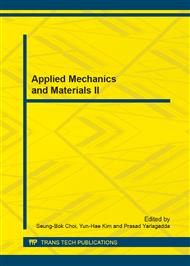p.1210
p.1214
p.1225
p.1229
p.1234
p.1238
p.1242
p.1246
p.1255
Influence of Free Volume on Residual Solvents of SiO2 Modified Polypropylene Films
Abstract:
Nano inorganic particles, as a kind of rigid inorganic particles, can combine the characteristics of organic polymers and inorganic to obtain the composite materials with excellent comprehensive properties. In this thesis, nanosilica after surface modification was used as the modified agent, adding to polypropylene materials to get a series of polypropylene films with different content of nanosilica. Free volume characterizations of different polypropylene films were measured using the positron annihilation lifetime spectroscopy technique, and the residual solvents values were measured. Researches show that the free volume of polypropylene films changes result from the changes of nanosilica content. With the free volume of polypropylene films decreases, the residual solvents values become lower.
Info:
Periodical:
Pages:
1234-1237
Citation:
Online since:
December 2013
Authors:
Keywords:
Price:
Сopyright:
© 2014 Trans Tech Publications Ltd. All Rights Reserved
Share:
Citation:


